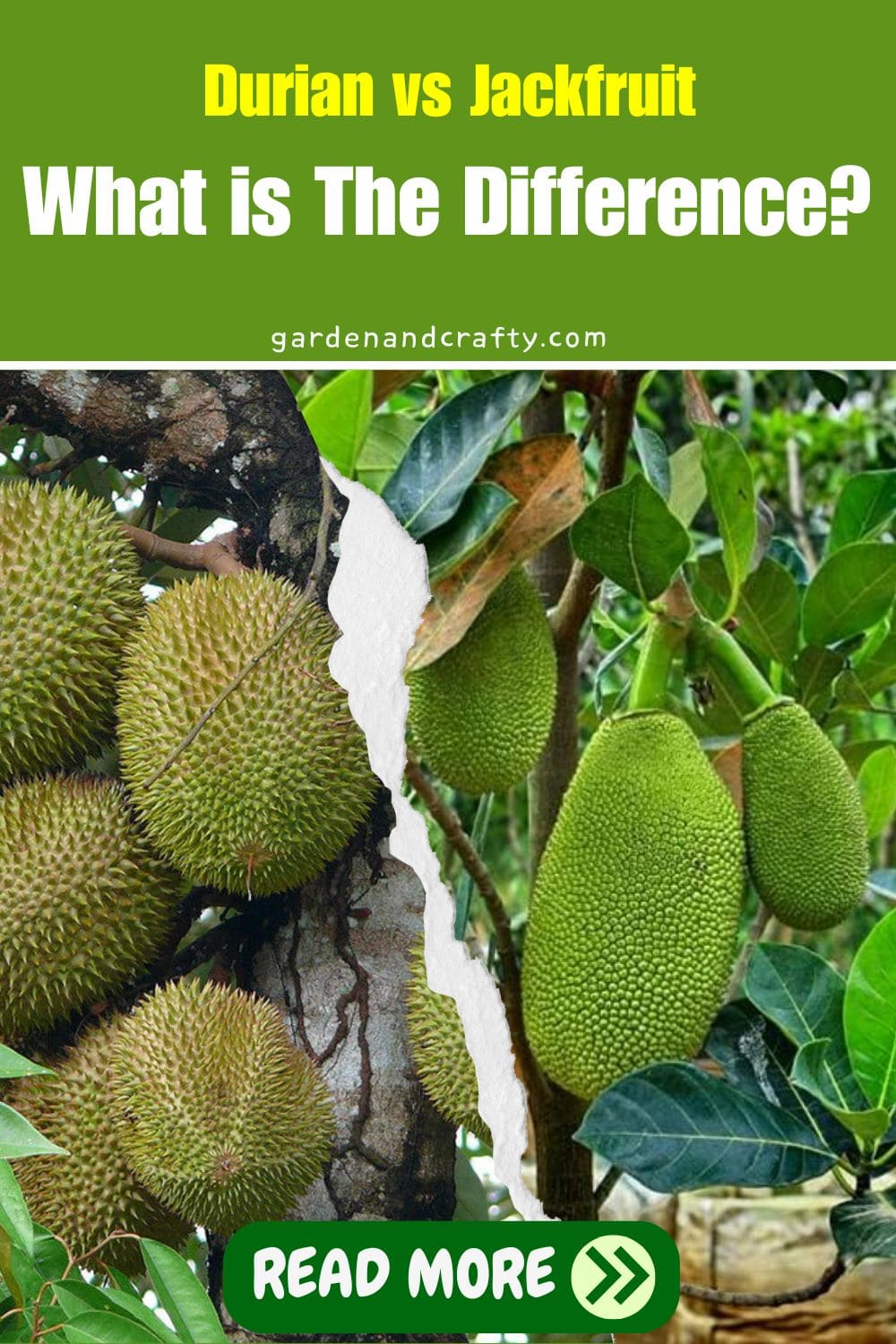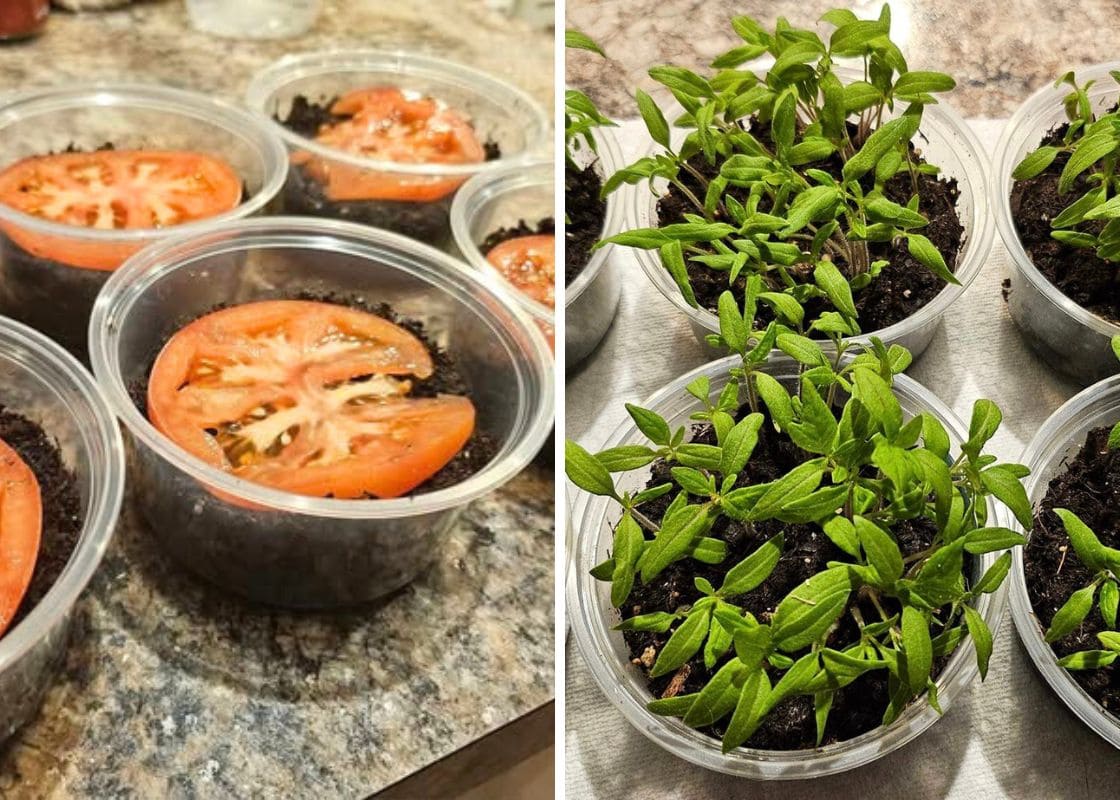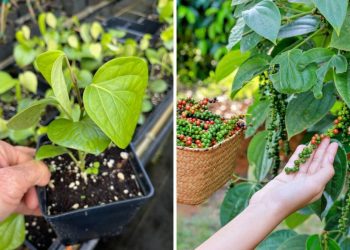If you’re a fan of tropical fruits, you’ve probably encountered the exotic allure of durian and jackfruit. Both fruits are giants in their own right, offering unique flavors and aromas that captivate and sometimes challenge even the most adventurous palates.
While jackfruit stands out as the largest fruit in the world, durian is called the “king of fruits” for its formidable presence and intense aroma.
In my journey through Southeast Asia, I’ve had the opportunity to savor both of these remarkable fruits and learn about their distinct qualities.
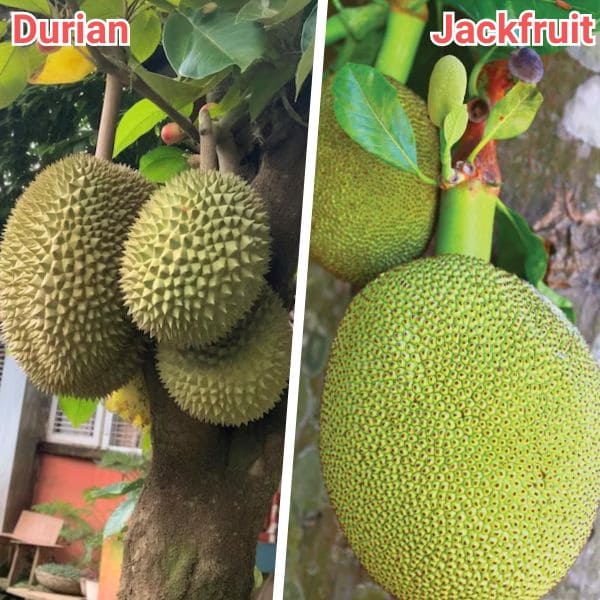
| Durian | Jackfruit | |
| Scientific name | Durio | Artocarpus heterophyllus |
| Common name | Durian | Jackfruit |
| Plant type | Evergreen tree | Evergreen tree |
| Plant Height | 25-50 meters | 10-30 meters |
| Fruit | Spiky, strong odor | Large, fibrous, sweet |
| Fruit Size | 15-30 cm diameter, 1-3 kg | 30-90 cm length, 10-25 kg |
| Taste | Sweet, creamy, custard-like | Sweet, fruity, sometimes meaty |
| Processing products | Durian chips, paste, candy | Jackfruit chips, canned jackfruit, jackfruit flour |
| Harvest season | Varies by region, typically mid-year | Varies by region, typically summer |
The Differences Between Durian vs Jackfruit
Botanical Structure
Durian trees can tower up to 50 meters, making them a majestic sight. Their broad, oblong leaves are glossy and dark green, providing ample shade beneath the canopy.
In contrast, jackfruit trees typically grow between 10 to 30 meters in height. They have dense, glossy green leaves that are elliptical in shape and can grow up to 25 centimeters long.
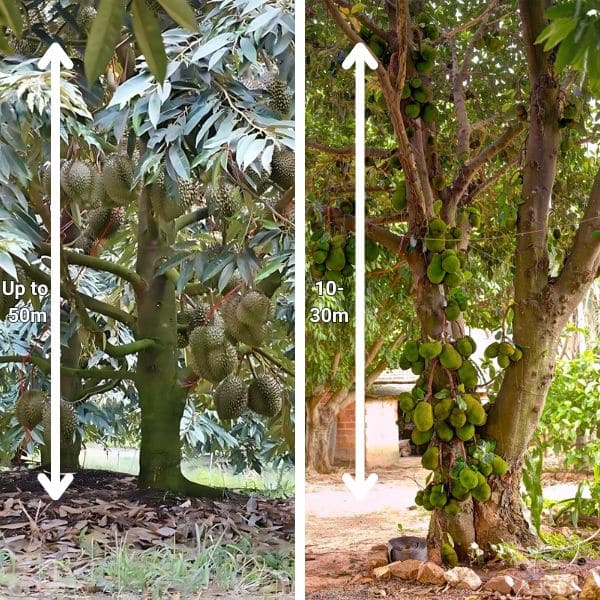
Durian flowers are unique, blooming directly on the trunk and large branches in clusters. These flowers are large, with a creamy white or pale yellow hue, and they emit a strong fragrance at night to attract pollinators like bats.
Jackfruit flowers are much smaller compared to durian flowers and are unisexual, with male and female flowers appearing on the same tree but in different clusters. The female flowers develop into the enormous jackfruits, which grow directly from the trunk and larger branches.

Physical Characteristics
Durian, often crowned as the “king of fruits,” is easily recognizable by its formidable spiky, hard outer shell. This unique armor serves as a natural defense mechanism and encases a fruit that typically ranges from 15 to 30 centimeters in diameter and weighs between 1 to 3 kilograms.
The spikes are not just for show; they can be quite sharp and need careful handling. Inside, the durian’s flesh is creamy and custard-like, with a potent aroma that divides opinions worldwide.
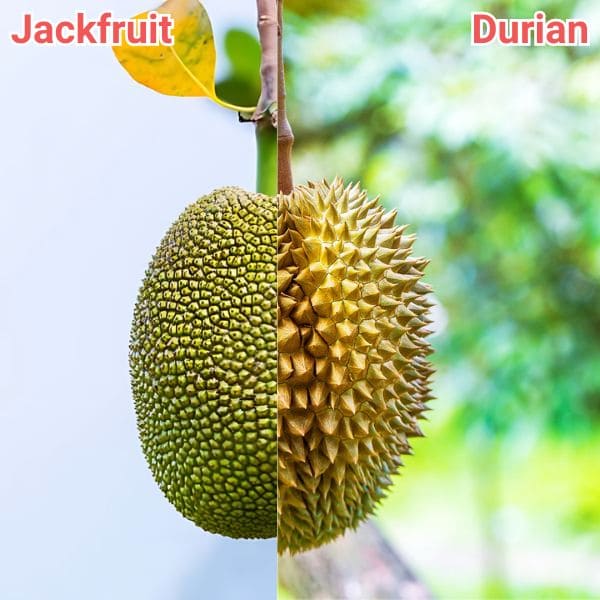
In stark contrast, jackfruit stands as the largest tree-borne fruit in the world. Its bumpy, green exterior is less intimidating to the touch.
Jackfruits can reach impressive sizes, measuring between 30 to 90 centimeters in length and weighing a hefty 10 to 25 kilograms. Inside, the fruit is composed of numerous sweet, fibrous bulbs that can be eaten raw or cooked, providing a versatility that durian doesn’t offer.
Odor and Flavor
The odor of durian is often described as controversial – some people love it, while others find it overpowering.
When I first tried durian, I was struck by its intense aroma that filled the room instantly. The taste, however, was a pleasant surprise: sweet, creamy, and custard-like, with a complexity that’s hard to find in other fruits.
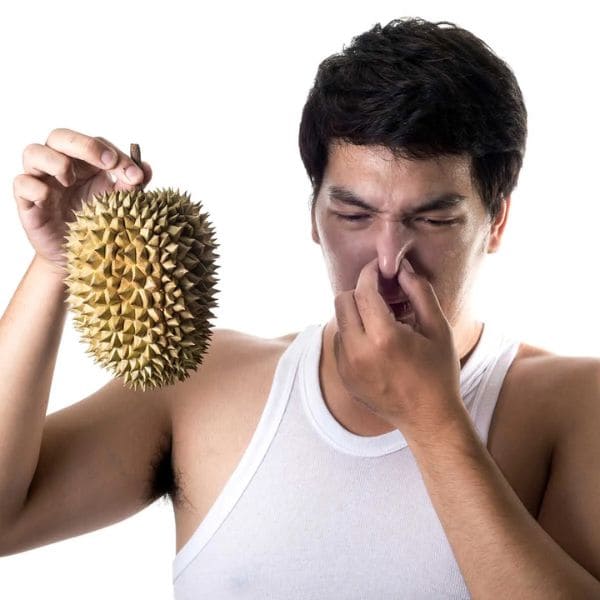
Jackfruit, on the other hand, greets you with a much milder, fruity aroma. Depending on its ripeness, the smell can range from subtle to quite strong, but it’s generally more universally appealing than durian’s.
The flavor of jackfruit is equally delightful-sweet and fruity, sometimes with a hint of a meaty texture when unripe.
Nutritional Content
Durian is notably higher in calories, fats, and dietary fiber, making it a great energy booster.
For instance, a 100-gram serving of durian provides approximately 147 calories, 5 grams of fat, and 3.8 grams of dietary fiber. It’s packed with vitamins like vitamin C (19.7 mg) and B-complex vitamins, along with essential minerals such as potassium (436 mg) and manganese (0.3 mg).
When I indulged in durian during my travels, I could feel an immediate energy lift, which makes sense given its dense nutritional profile.
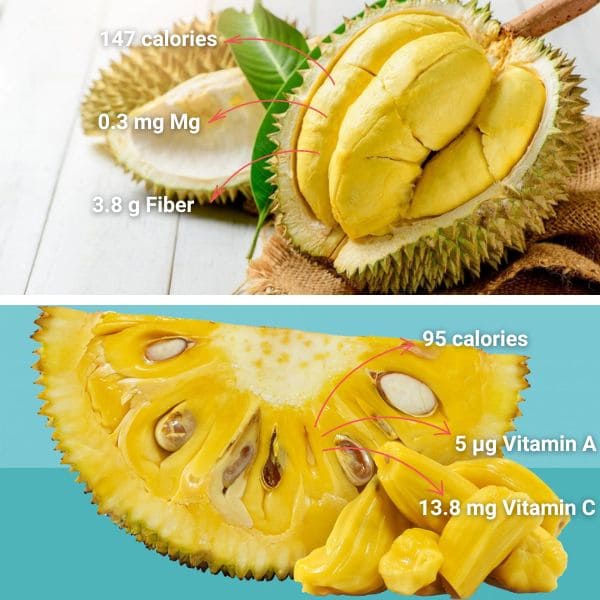
Jackfruit stands out for its high fiber content, it is excellent for digestion.
A 100-gram serving of jackfruit provides around 95 calories, 0.6 grams of fat, and 1.5 grams of dietary fiber. It’s lower in calories compared to durian but rich in vitamin A (5 µg), vitamin C (13.8 mg), and various antioxidants. I often enjoyed jackfruit as a light, refreshing snack that left me feeling full without being weighed down.
While jackfruit is twice as high as vitamin A in durian, durian excels in iron, phosphorus and manganese. Their fruits are powerhouses of health benefits.
Culinary Uses
Durian is typically enjoyed fresh. Its creamy, custard-like texture and sweet taste make it a popular choice in desserts and candies. Its distinctive taste can also be found in pastries, cakes, and even savory dishes like durian fried rice in some Southeast Asian cuisines.
Jackfruit, on the other hand, is incredibly versatile. When ripe, it’s eaten fresh, offering a sweet and fruity treat. However, its true versatility shines when it’s unripe. Unripe jackfruit, with its fibrous, meaty texture, is an excellent meat substitute.
I’ve enjoyed it in various savory dishes, from jackfruit curry to pulled “pork” sandwiches. It also fits well in sweet dishes like jackfruit pudding and cakes. This adaptability makes jackfruit a favorite among vegetarians and vegans looking for plant-based alternatives.
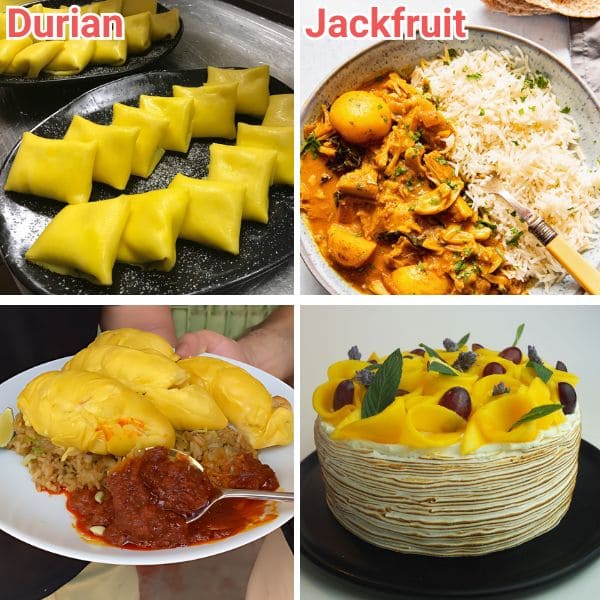
Harvest Season
Durian, native to Southeast Asia, has a harvest season that varies depending on the region. Typically, you’ll find durian in abundance around mid-year. I remember traveling through Malaysia during durian season and seeing markets overflowing with this spiky fruit, their pungent aroma filling the air.
Jackfruit, on the other hand, also varies by region but is generally harvested in the summer months. Native to South and Southeast Asia, jackfruit trees produce their massive fruits in the warmest part of the year.
Economic Impact and Market Presence
Durian generates significant export revenue, particularly in countries like Thailand, Malaysia, and Indonesia. Its strong market presence is driven by high demand in places like China and Singapore, where the fruit’s unique flavor and status as a delicacy command premium prices.
Jackfruit has a robust local market value due to its versatility and nutritional benefits. It’s not just a staple in local diets but also gaining popularity internationally, especially as a plant-based meat substitute.
I’ve seen jackfruit’s market presence grow steadily in vegetarian and vegan circles in the West, where it’s hailed for its texture and ability to absorb flavors.
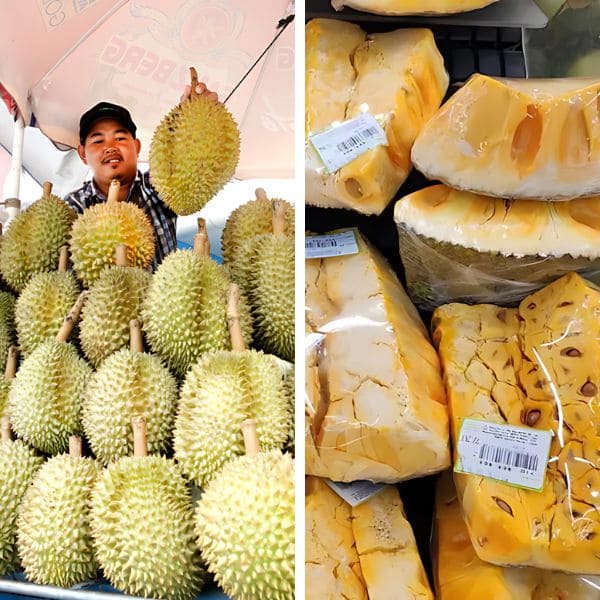
Cultural Significance
Durian is celebrated in various festivals across Southeast Asia. In Malaysia and Thailand, for instance, there are entire events dedicated to tasting and honoring durian.
I attended a durian festival in Penang, Malaysia, where the durian was not only enjoyed in its fresh form but also featured in contests and traditional folklore performances.
Jackfruit is also important in South and Southeast Asia. In India, jackfruit is a staple during certain regional festivities. In a festival in Kerala where jackfruit is used in everything from curries to desserts, emphasizing its culinary importance.
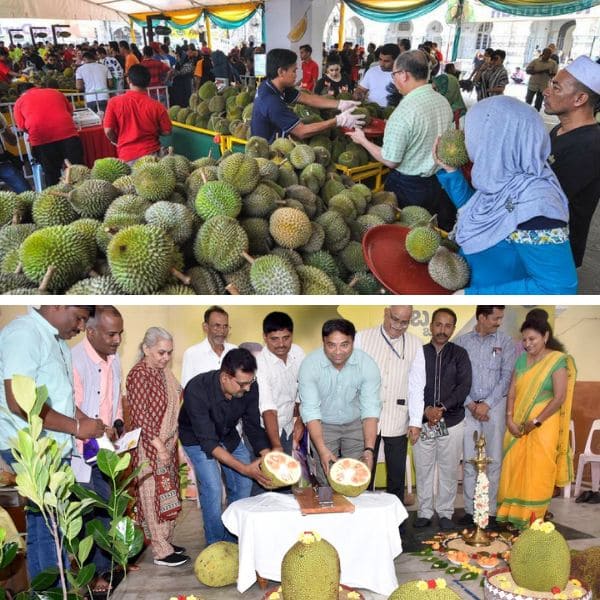
The Similarities Between Durian vs Jackfruit
Environmental Preferences
Belonging to the Moraceae family, both fruits, both durian and jackfruit thrive in tropical climates, flourishing best in well-drained soil. If you’re thinking of cultivating these fruits, ensure they have the warmth and well-drained soil they need to thrive.
Health Benefits
Both fruits exhibit antibacterial, antioxidant, anti-inflammatory, antidiabetic, anti-lipidemic, and anticancer properties, making them subjects of extensive research.
These fruits are rich in antioxidants like phenolic compounds, flavonoids, carotenoids, and vitamin C, which help protect cells and reduce inflammation. For cardiovascular health, jackfruit leaf extract can reduce blood glucose and cholesterol levels, improving glucose tolerance. Similarly, durian rind extract can lower blood glucose levels in diabetic rats.
Jackfruit also has powerful anticancer properties, effective against colorectal, hepatic cancers, and leukemia. Durian’s high fiber content aids digestion, prevents constipation, and reduces the risk of colorectal cancer. High-fiber diets are also linked to lower risks of cardiovascular diseases, diabetes, and obesity.
Seed Consumption
Have you ever tried roasted durian and jackfruit seeds? I remember enjoying them with a sprinkle of salt – a simple yet delicious snack.
The seeds have a nutty flavor and are surprisingly nutritious, packed with proteins and minerals. These seeds are not only tasty but also provide an excellent way to reduce food waste and utilize every part of these incredible fruits.
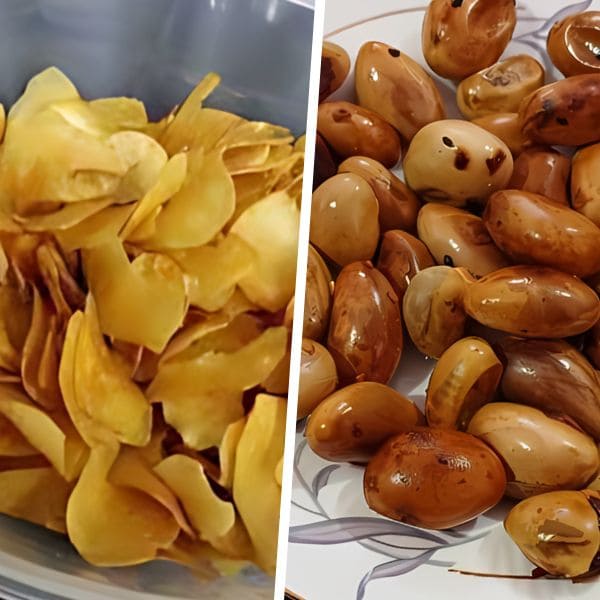
What to Choose Between Durian vs Jackfruit
Taste and Preference
If you enjoy strong, creamy flavors and don’t mind a potent smell, durian might be suitable. Its unique taste is often described as custard-like with hints of almond.
On the other hand, if you prefer a milder, fruity taste or are looking for a versatile meat substitute, jackfruit is ideal. Its sweet flavor and fibrous texture make it perfect for both sweet dishes and savory meals. For vegetarians, jackfruit is a fantastic option due to its ability to mimic the texture of meat when unripe.
Nutritional Needs
If you’re looking for an energy boost, durian is an excellent choice. It’s high in calories and packed with healthy fats, making it a great snack for sustained energy.
Conversely, if digestion and fiber intake are your priorities, jackfruit is the way to go. It’s high in dietary fiber, which aids in digestion and helps maintain a healthy gut. Its fiber content is particularly beneficial for vegetarians looking to maintain a balanced diet.
Economic Considerations
Durian tends to be more expensive. Its strong market demand, especially in places like China and Singapore, drives up the price. I remember seeing durian prices in a Bangkok market and being surprised by how high they were.
Jackfruit, on the other hand, is generally more affordable and widely available. In many South and Southeast Asian countries, jackfruit is a common sight in local markets and is priced reasonably. I often found jackfruit to be a cost-effective choice for both sweet and savory dishes during my travels in India.
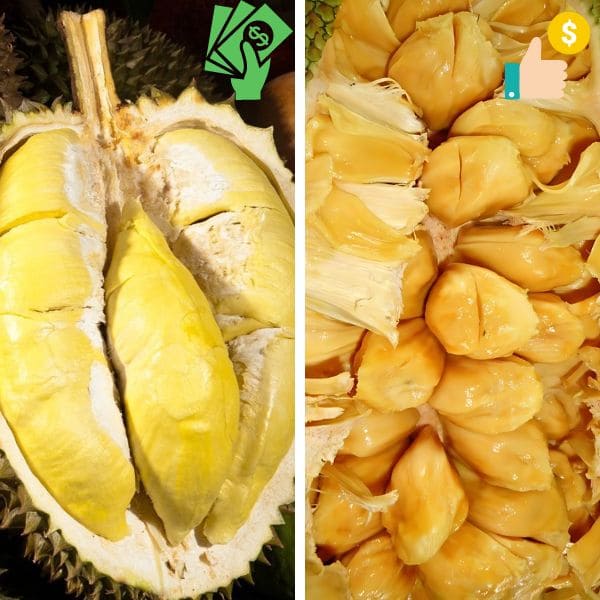
FAQs
Are durian and jackfruit related?
Yes, durian and jackfruit are related as they both belong to the Moraceae family, although they are different genera (Durio for durian and Artocarpus for jackfruit).
How do I store durian and jackfruit?
Both durian and jackfruit should be stored in a cool, dry place if not consumed immediately. Durian can be refrigerated to extend its shelf life. Jackfruit can also be refrigerated, and its seeds should be stored in a dry place to prevent spoilage.
How are durian and jackfruit propagated?
Both fruits can be propagated through seeds, cuttings, or grafting. Grafting is preferred for durian to ensure fruit quality, while jackfruit is often grown from seeds due to its robustness.
Why is durian fruit controversial?
Durian is controversial due to its strong, pungent odor, which some people find unpleasant. This intense smell has led to durian being banned in many public places, including hotels and public transport, in some countries. Despite its divisive aroma, many people love its unique taste and creamy texture.
